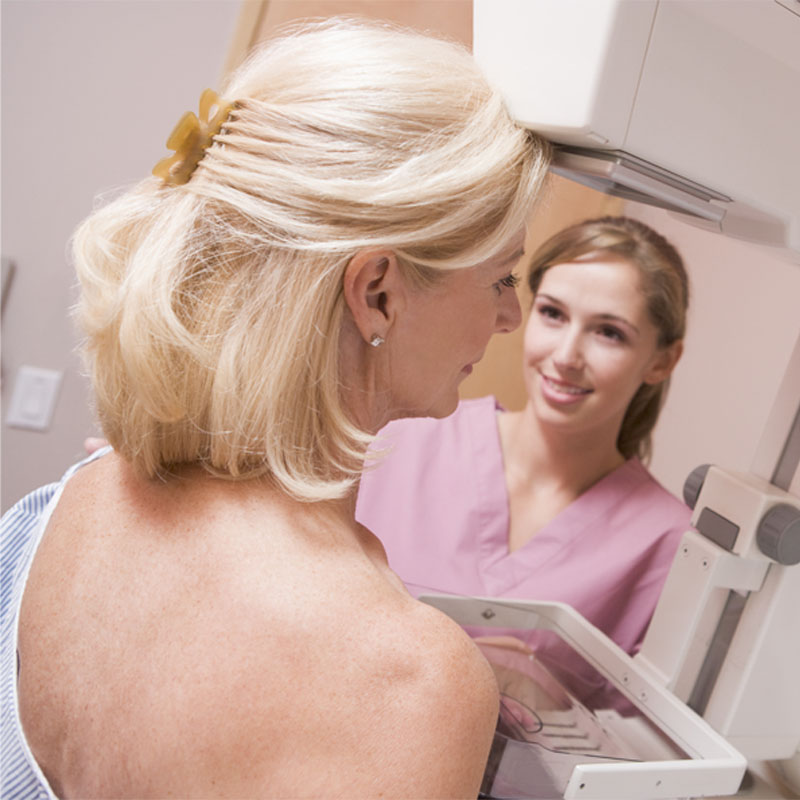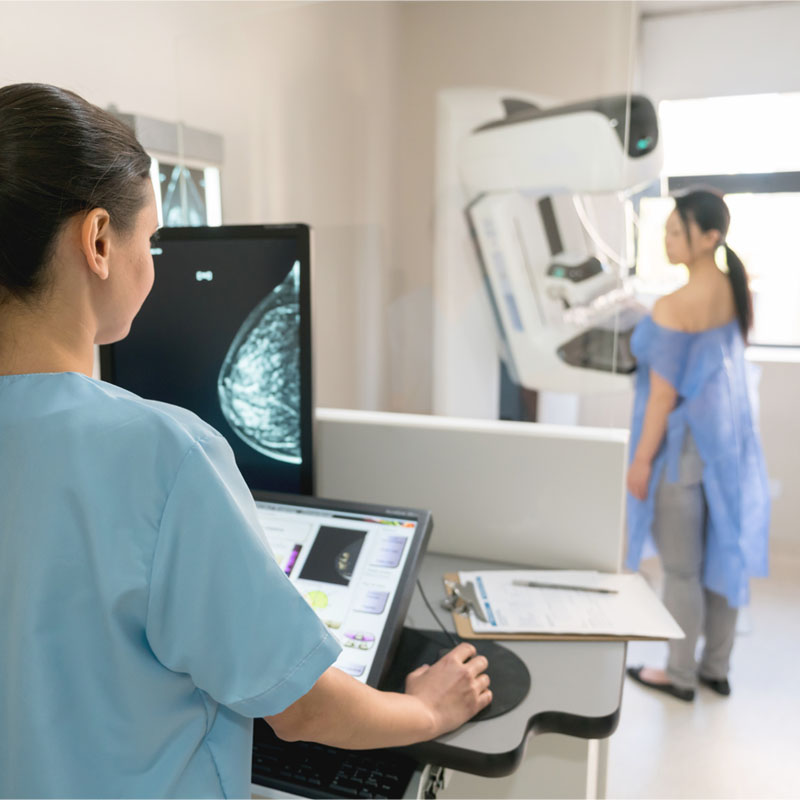Breast Cancer Screening
A mammogram is an X-ray used to detect cancer before they have any signs or symptoms of the disease.
- Screening mammograms consist of two images of each breast and detect lumps or other abnormalities.
- A diagnostic mammogram is used to diagnose after a lump or abnormalities in the breast have been found. It consists of more X-rays than screening mammography and therefore takes longer to complete. They can also be used if there is difficulty seeing breast tissue in a screening mammogram in some circumstances, such as the presence of breast implants.
3D Mammography takes multiple images or X-rays, of breast tissue to recreate a 3-dimensional picture of the breast. You may also hear it called breast tomosynthesis.
Breast ultrasounds use sound waves to produce pictures of the internal structures of the breast. They are primarily used to help diagnose breast lumps or other abnormalities your doctor may have found during a physical exam, mammogram, or breast MRI. These are safe, non-invasive, and do not use radiation.
Breast MRIs are more detailed than a mammogram and are used to examine tiny masses or changes in the breast that are difficult to be seen.
What to Expect During a Mammogram?
On the day of your mammogram you should:
- Wear a comfortable two-piece outfit.
- Do not use deodorant or any products which may contain talcum powder or lotion.
During your mammogram:
- You will be asked to undress from the waist up and put on a gown.
- Once the radiologist is ready to see you, you will go to the mammography room and disrobe.
- Your breast is then placed on a special platform and slowly compressed until it is flattened.
- You may feel discomfort or pressure for several seconds until your breast is released.
- The procedure is repeated until each breast is imaged twice from two different angles.
- The entire process of getting a mammogram generally takes about 30 minutes.
Mammogram Results:
- A radiologist reviews the images and sends the results to your doctor’s office.
- You should get your results within a week from your mammogram appointment.
- If an abnormality is found, more imaging or additional tests such as a biopsy may be needed.
Women should begin scheduling their annual mammograms at the age of 40. Detecting breast cancer at its earliest stage is crucial to survival. Having an annual mammogram is an important first step in diagnosing breast cancer. Schedule your mammogram today!

What Does your Doctor Look for in a Mammogram?
Mammograms are read by radiologists, doctors who are specifically trained in diagnosing and treating diseases and injuries by using imaging techniques such as x-rays. There are different types of signs your doctor will look for while looking at your mammogram:
Calcifications are mineral deposits that look like white spots on a mammogram. There are two types of calcifications:
- Macrocalcifications- large, coarse calcium deposits usually caused by aging breast arteries, injuries, or inflammation. Macrocalcifications are related to benign conditions and usually do not require a biopsy. Such deposits are common in women over 50 years old.
- Microcalcifications- small calcium deposits in the breast. Doctors are more suspicious of microcalcifications; however, that does not mean that they are always cancerous. In some cases, a biopsy is needed to determine if cancer is present.
A mass is a region in breast tissue that looks abnormal. These can be caused by several things such as cysts or solid masses:
- Simple Cysts- fluid-filled sacs are benign and do not need to be biopsied. Sometimes an ultrasound or a needle aspiration is needed to determine if the mass is a simple cyst or a solid mass.
- Tumor- solid masses which cause more concern and are usually watched with regular mammograms, ultrasounds, or tested with biopsies.
Breast Density- is based on how the different types of tissue in your breast are distributed. Dense breasts are not always abnormal but may be linked to a higher risk of developing breast cancer. Dense breasts can make it more difficult to see abnormal spots in mammograms. In some cases, additional tests may be needed to determine if a woman is at risk for having or developing breast cancer.
Having a record of your previous mammograms is very important. It can help your doctor see the changes your breast tissue has gone through.
